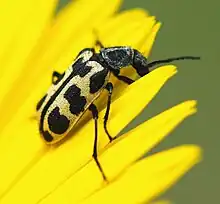| Astylus atromaculatus | |
|---|---|
 | |
| Scientific classification | |
| Domain: | Eukaryota |
| Kingdom: | Animalia |
| Phylum: | Arthropoda |
| Class: | Insecta |
| Order: | Coleoptera |
| Infraorder: | Cucujiformia |
| Family: | Melyridae |
| Genus: | Astylus |
| Species: | A. atromaculatus |
| Binomial name | |
| Astylus atromaculatus (Blanchard, 1843) | |

Dorsal aspect
Astylus atromaculatus is a species of beetle in the family Melyridae. It is variously known as the spotted maize beetle, or pollen beetle. It is indigenous to Argentina and neighbouring countries, but has been accidentally imported into various other regions such as the warmer regions of North America and much of Africa, where it has become invasive.[1]
Description
Adult Astylus atromaculatus are roughly oval in shape, slightly elongated, with parallel sides. They generally are slightly flat in shape, and like most Melyridae, tend to be soft and leathery in texture. They attain about 12 mm in bodily length by 5 mm wide. They are finely bristly with finely punctured elytra and upper surfaces. The body colour is generally black, but with pale hairs on the pronotum surrounding two large, eye-like dorsal black patches. However, the most conspicuous feature is the colour scheme of the elytra; they are yellow to orange with a black median stripe along their margins where the folded elytra meet. Two blotches on that median stripe form cross-marks, one about 2 mm from the anterior end of the line, and one about 1 mm from the posterior end. Each elytron has three much larger black blotches on its dorsolateral surface near its lateral margin. The filiform antennae have eleven antennomeres.
The larvae are covered with long, silky setae, brown to reddish in colour.[2]
Biology
The adult Astylus atromaculatus are herbivorous, particularly being attracted to flowers and feeding on pollen. In this role they are not much of an agricultural problem and for some crops, such as sunflowers, it is suggested that they are more beneficial as pollinators than they are harmful as crop pests. In particular they feed on pollen from wind-pollinated plants such as maize, sorghum and other grain crops in the Poaceae, and also various Cyperaceae. During the high season they may crowd inflorescences at certain times of the day.
The larvae might be more harmful, feeding in the ground on decaying plant matter, but also feeding on seeds and germinating seedlings.[3] On the other hand, in South Africa they have been reported to be minor predators of stem borers in grain sorghum and maize.[4]
Especially in the countries where they are invasive and where presumably their natural enemies are absent, Astylus atromaculatus may become sufficiently numerous to cause significant crop damage. However, it is arguable whether it is ever worth applying special pest control treatments, rather than at most modifying other routine applications to accommodate their control.[1] There is however a concern that infestations could seriously damage rice harvests by causing apparent sterility; unlike the situation in maize, in which the male and female flowers are separate, rice female flowers can be seriously damaged by pollen-feeding beetles.
Veterinary significance
Like possibly all Melyridae, Astylus atromaculatus is undoubtedly poisonous; livestock deaths have resulted from swallowing large numbers of beetles in their fodder or in pastures. Though this is not a routine event, it has been confirmed by actual investigation, for example when cattle on the Springbok flats in South Africa ingested heavily infested pasture. The beetle populations commonly peak during midsummer and autumn, when they feed mainly on pollen from grain crops. When there are too few crops such as sunflowers and maize, the beetles are prone to concentrate on grasses, and on forbs in flower.
Poisoning caused severe diarrhoea with dark faeces and large quantities of mucus, rapidly followed by weakness and stasis of the rumen. Post mortem, beetles were found in large numbers in the rumen, associated with symptoms of dramatic congestion and irritation of the abomasum and haemorrhagic pseudomembranous intestinal enteritis. Because no treatment has proven effective for severely poisoned animals, it is necessary to keep livestock out of pastures while the plants are full of beetles, typically in the cool of mornings and evenings while the insects are inactive and not prone to scatter when alarmed by grazing activities. Yellow trays of detergent solution have been shown to trap the beetles, though it is not clear that they are an effective measure in reducing heavy infestations.[5][6]
References
- 1 2 Annecke, D. R.; Moran, V. C. (1982). Insects and mites of cultivated plants in South Africa. London: Butterworths. ISBN 0-409-08398-4.
- ↑ Astylus atromaculatus. National Pest Surveillance and Monitoring Systems - SENASA (Health and Quality Agrifood National Service)"Astylus atromaculatus | Sinavimo". Archived from the original on 2014-04-24. Retrieved 2014-04-24.
- ↑ "Astylus atromaculatus | Sinavimo". Archived from the original on 2014-04-24. Retrieved 2014-04-24.
- ↑ ARC-Plant Protection Research Institute (ARC-PPRI) Natural Enemies of Cereal Stemborers Archived 2014-04-24 at the Wayback Machine
- ↑ Annual Report 1 April 1991 to 31 March 1992, South African Department of Agriculture, Directorate of Animal Health.
- ↑ Van den Berg, J., Torto, B., Pickett, J. A., Smart, L. E., Wadhams, L. J. and Woodcock, C. M. 2008. Influence of visual and olfactory cues on field trapping of the pollen beetle, Astylus atromaculatus (Col.: Melyridae). Journal of Applied Entomology 132(6): 490 – 496.